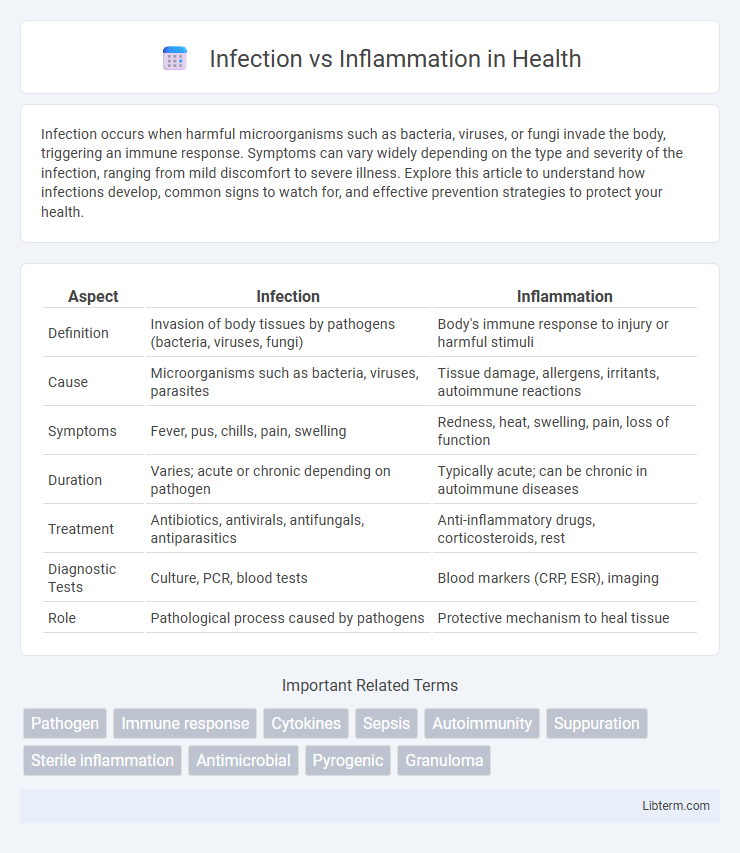Infection occurs when harmful microorganisms such as bacteria, viruses, or fungi invade the body, triggering an immune response. Symptoms can vary widely depending on the type and severity of the infection, ranging from mild discomfort to severe illness. Explore this article to understand how infections develop, common signs to watch for, and effective prevention strategies to protect your health.
Table of Comparison
| Aspect | Infection | Inflammation |
|---|---|---|
| Definition | Invasion of body tissues by pathogens (bacteria, viruses, fungi) | Body's immune response to injury or harmful stimuli |
| Cause | Microorganisms such as bacteria, viruses, parasites | Tissue damage, allergens, irritants, autoimmune reactions |
| Symptoms | Fever, pus, chills, pain, swelling | Redness, heat, swelling, pain, loss of function |
| Duration | Varies; acute or chronic depending on pathogen | Typically acute; can be chronic in autoimmune diseases |
| Treatment | Antibiotics, antivirals, antifungals, antiparasitics | Anti-inflammatory drugs, corticosteroids, rest |
| Diagnostic Tests | Culture, PCR, blood tests | Blood markers (CRP, ESR), imaging |
| Role | Pathological process caused by pathogens | Protective mechanism to heal tissue |
Understanding Infection and Inflammation
Infection occurs when harmful pathogens such as bacteria, viruses, or fungi invade the body, triggering immune responses to eliminate them. Inflammation is the body's protective mechanism characterized by redness, swelling, heat, and pain, aimed at isolating and repairing affected tissues. Understanding the differences between infection and inflammation is vital for accurate diagnosis and effective treatment strategies in clinical medicine.
Key Differences Between Infection and Inflammation
Infection involves the invasion of pathogenic microorganisms such as bacteria, viruses, or fungi that cause tissue damage and trigger immune responses, whereas inflammation is the body's localized protective response to harmful stimuli, including infections, injuries, or irritants. Key differences include the cause, with infection specifically caused by pathogens, and inflammation, which can occur without infection as a general defense mechanism. Infection often presents with symptoms like fever and pus formation, while inflammation is characterized by redness, swelling, heat, and pain at the affected site.
Causes of Infection
Infection is caused by the invasion and multiplication of pathogenic microorganisms such as bacteria, viruses, fungi, or parasites within the body. These microbes disrupt normal cellular functions, leading to tissue damage and eliciting an immune response. Key factors contributing to infection include weakened immune defenses, exposure to contaminated environments, and breaches in skin or mucosal barriers.
Triggers of Inflammation
Inflammation is triggered by a variety of factors including pathogens such as bacteria, viruses, and fungi, as well as physical injury, chemical irritants, and immune system reactions. The innate immune response activates inflammatory mediators like cytokines, histamines, and prostaglandins to isolate and eliminate harmful stimuli. Unlike infection, which specifically involves microbial invasion and replication, inflammation can also result from non-infectious causes such as autoimmune diseases, allergens, and tissue damage.
Signs and Symptoms: How to Tell Them Apart
Infection often presents with localized redness, warmth, swelling, pain, and systemic symptoms like fever or chills due to the presence of pathogens. Inflammation manifests as a protective response causing redness, heat, swelling, and pain but may lack systemic signs unless severe. Differentiating infection from inflammation involves assessing symptoms like purulent discharge or fever indicating infection, while sterile inflammation typically shows similar local symptoms without microbial involvement.
Diagnostic Methods for Infection and Inflammation
Diagnostic methods for infection typically involve microbiological cultures, polymerase chain reaction (PCR) assays, and serological tests to identify specific pathogens. In contrast, inflammation is often diagnosed through laboratory markers such as elevated C-reactive protein (CRP), erythrocyte sedimentation rate (ESR), and imaging studies like MRI or ultrasound to assess tissue changes. Both conditions may require biopsy or histopathological examination for definitive diagnosis, particularly when distinguishing infectious from non-infectious inflammatory processes.
Common Types of Infections
Common types of infections include bacterial infections like strep throat and urinary tract infections, viral infections such as influenza and the common cold, and fungal infections including athlete's foot and candidiasis. These infections trigger the body's immune response, often leading to inflammation characterized by redness, swelling, heat, and pain at the affected site. Differentiating between infection and inflammation is crucial, as inflammation can occur without infection, such as in autoimmune diseases or allergic reactions.
Common Conditions Involving Inflammation
Infection occurs when harmful microorganisms such as bacteria, viruses, or fungi invade the body, triggering the immune response, while inflammation is the body's protective reaction to injury or infection, characterized by redness, swelling, warmth, and pain. Common conditions involving inflammation include rheumatoid arthritis, characterized by joint inflammation and pain, inflammatory bowel disease (IBD) causing chronic inflammation of the digestive tract, and asthma which results in airway inflammation leading to breathing difficulties. Understanding the distinction between infection and inflammation is critical for diagnosing and effectively managing these prevalent inflammatory conditions.
Treatment Strategies for Infection vs Inflammation
Treatment strategies for infection primarily involve the use of targeted antimicrobial agents such as antibiotics, antivirals, or antifungals tailored to the specific pathogen identified through diagnostic testing. In contrast, inflammation treatment focuses on controlling the immune response with anti-inflammatory medications like nonsteroidal anti-inflammatory drugs (NSAIDs), corticosteroids, or biologics to reduce tissue damage. Accurate differentiation between infection and inflammation is critical to avoid inappropriate use of antibiotics and ensure appropriate therapeutic interventions.
Preventive Measures and Lifestyle Tips
Infection prevention centers on maintaining hygiene, vaccination, and avoiding contact with infectious agents, while inflammation management emphasizes a balanced diet rich in antioxidants, regular exercise, and stress reduction to modulate the immune response. Handwashing, using disinfectants, and timely medical intervention help control pathogen spread, whereas anti-inflammatory foods like turmeric and omega-3 fatty acids aid in reducing chronic inflammation. Adequate sleep, smoking cessation, and limiting alcohol consumption further support immune health and prevent both infection and inflammation-related complications.
Infection Infographic

 libterm.com
libterm.com